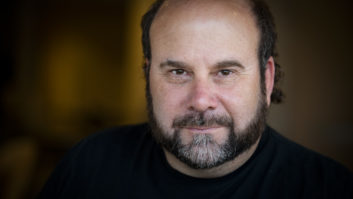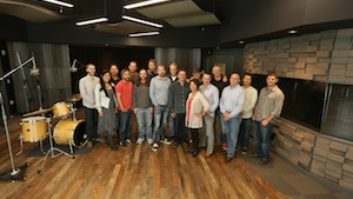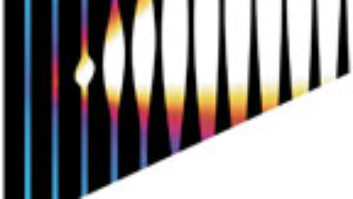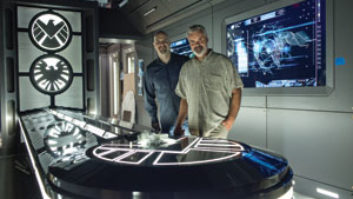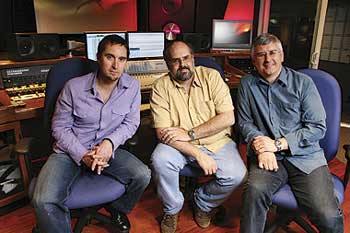
It’s as if the garage band suddenly stepped out and played the House of Blues. Or the art-house videographer submitted a high-def buddy film to Sundance and won. The world of videogame sound, still the province of renegades and tweakers, innovators and futurist electronics heads, is growing up. Next-gen engines are in place. Dolby True HD 7.1 sound is a reality. And facilities are being built. In a big way.
While a whole lot of people contribute to the planning and execution of a facility this size, the Sony brain trust revolved around, l to r, Chuck Doud, director of music; Buzz Burrowes, director, tools, technology & services group; and Dave Murrant, sound design manager.
Photo: Court Mast
Electronic Arts in Vancouver and the San Francisco Bay Area. Bungie in Kirkland, Wash. Midway in San Diego and Chicago. Technicolor Interactive in L.A. And now Sony Computer Entertainment America presents a model for the new means of interactive audio production.
“They’re doing film, animation, motion capture, music, effects, dialog — only in a much more complex way, so their facilities require even more attention than a film lot would,” says facility designer Chris Pelonis. “It’s every aspect of entertainment production you can imagine piled into one product.”
That product now includes PlayStation 3 and its burgeoning number of titles. But the facilities were built on the backs of PlayStation 2, the most successful of the game engines.
“We were already seeing on PS2 games that with the volume of content, we clearly needed more engineers and more space,” says SCEA’s Buzz Burrowes, director, tools, technology and services group, and a former Record Plant assistant who cut his code teeth troubleshooting GML automation systems. “If you took the number of hours for linear cinematic sequences in a typical game end-to-end and figure out the time, you’re talking six to seven feature films of audio post. Then we hear that the next generation is going to be high-def, 1080p, Dolby True HD. We thought it made sense to have an investment in the future.”
The initial facility upgrade plan that Burrowes turned over to Dave Murrant, sound design manager, called for adding a few more edit cubes and another mix room and live space/Foley room. Work began, but then shifted direction once the high-quality foundation of PS3 became known and 10-year-old sister facilities in Foster City (south of San Francisco) found open space. Murrant and Burrowes had a lunch with Pelonis, and soon after, the project began evolving and mutating into more rooms, a deeper acoustic integrity and a need for flexible, accurate spaces.
“We cover so many disciplines, but it’s not like we can build a room for each one,” says Murrant. “We need the Foley room to accommodate music. The mix room needs to do Foley or dialog or music. It wasn’t a surprise. It was a requirement from the start that an editor could walk from room to room with confidence that it’s true. That’s why the Pods are standardized.”
The 180-square-foot Pods (read: edit/mix rooms) actually form the nexus in Sony’s new model: the multipurpose space. The two new mix rooms are full-range 7.1, the Foley room is loud and dead-quiet at the same time, but the 20 full-range, D-Control/Pro Tools-equipped 5.1 Pods, split between Foster City and San Diego and constructed at roughly the same time, form the seal in the edit/mix connection.

The Foley/live room was designed to handle everything from the softest breath to a rock ’n’ roll band or car doors being beaten by 2x4s. “Dave Murrant constantly pushed for the highest standards throughout the whole facility from day one,” Pelonis says. “That’s what the Foley room is about. He wanted a big, girthy sound while maintaining efficiency and intelligibility at the same time.” This was demonstrated by a Pelonis parlor trick, whereby he kept repeating a whisper as he walked backward some 30 feet to the opposite corner, without a noticeable loss of articulation or perceived level.
Photo: Ed Freeman
After the team pushed the concept, Pelonis built a full-range 5.1 mockup as proof of concept, then asked about speakers. Pelonis already builds a line of Dual-Concentric 15 mains through Tannoy, the Pelonis Signature Series. He proposed that Sony, looking to standardize for the Pods, give him a crack at a more near-field approach.
“They gave me the opportunity to design the speakers I’ve been wanting to design,” Pelonis says. “I set up shop in the mockup Pod and developed the electronics and the passive crossover. We spent hundreds of hours to get it right, and Sony was gracious to let me work there.”
After a listening test, Burrowes, Murrant and music director Chuck Doud out of Foster City ordered more than 100 of the new 10-inch 110Ps for the Pods (with 12-inch subs) and two sets of seven PS215A active double 15s (with a 16Hz 3dB down-point) for the mix rooms. Additionally, 18-inch subs take the bottom down to 5 Hz.
“We thought a lot before we put in a whole bunch of 5.1 Pods,” Burrowes recalls. “This is not the traditional approach. We could have put in a bunch of stereo rooms, but then you look at the number of titles we put out a year, and we are always mixing. We try to convince our young guys that they’re mixing when they have a microphone buried in the tailpipe of a car. We always have to be mixing.”
The Pods were an evolutionary development, but from the beginning, the Sony team knew they wanted a powerful mix room and a versatile live/Foley room. The mix room (on the cover), based around D-Control and Pro Tools, is 450 square feet of full-range 7.1/5.1 sound. After some initial hesitation, most everyone who has been in the room has switched to the mains for everyday editing/mixing.

Each of the 20 5.1 Pods is a THX-certified mix room. “The LCR speakers are flush-mounted,” Pelonis says, “but it’s in the mid-field rather than the typical near-field fashion for these types of rooms. They’re my new passive 10-inch speakers. The idea was to create really articulate environments for these guys so they could move from room to room with accurate translation, even if they come from Foster City to San Diego, or from any of the Pods to the mix room.”
Photo: Ed Freeman
“You don’t get fatigued because the system is very phase-accurate,” Pelonis says. “All of the time information arrives at you correctly. When you have mid and high frequencies arriving at a different time than the lows, your brain has to fix that. That’s where fatigue comes from. Then, of course, distortion is also fatiguing because your ears and brain and body don’t like to be bombarded. I’ve tried to mitigate phase distortion and harmonic distortion as much as possible in my speakers.”
As it’s shaken out in the first few months online, the San Diego mix facility, with its 15-foot ceiling, is handling a majority of dialog and effects, while the Foster City mix room, with its 9-foot ceiling (due primarily to HVAC considerations), concentrates on dialog and music. By all accounts, the tracks moving between the two translate seamlessly. Burrowes and Murrant describe the rooms as “true.”
Following the San Diego visit, Mix visited the Foster City facilities, home base for Burrowes and Doud, who had just returned from recording a 74-piece orchestra at Abbey Road, with score by John Debney, for the PS3 title Lair. Five years ago, Doud, a leading authority in music development for games, was constantly asked about licensing tracks from new and established acts. Today, he is more apt to talk about Decca Trees, ensemble cues and adaptive scores.
“The interesting thing about videogames,” Doud says, “is that it’s a lot more difficult to score a game than it is a film. You have to address it from a compositional level, from an implementing level and from a production level. We’ve been working with hybrids of a sort lately. We’ll go to an orchestral composer for thematic elements, and then we’ll go to a couple electronic guys and give them the multitracks, so what goes into the game is a hybrid. We end up innovating musically by bringing in some really interesting, fresh mixes to make it work. We might have two-and-a-half hours of music playing, and we need to figure out how it willl make musical sense through any transition the player might make. You have to anticipate every possible move, and it has to make musical sense.”
A lot of fine folks pushed, prodded and fought for the new facility; others contributed stellar work. The complex cable/wiring management system was designed and implemented by Matt Levine of Bug Id Productions. Construction in San Diego by Johnson and Jennings; Foster City, SC Builders. And facilities director Chris Castagno of Sony helped make the whole implementation possible.
“The people we tend to hire have passion for their work,” Murrant concludes. “Without the talent and the environment to work in, you won’t get the quality in the game. These guys do some crazy hours when the dev team is driving them, and they have to have an environment that is true, where they can make good decisions. If we can grow that talent, we’ll get better games.”
Tom Kenny is Mix’s editorial director.
